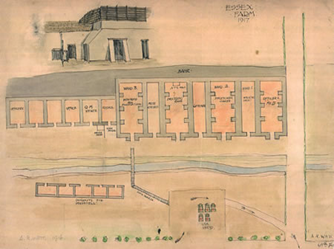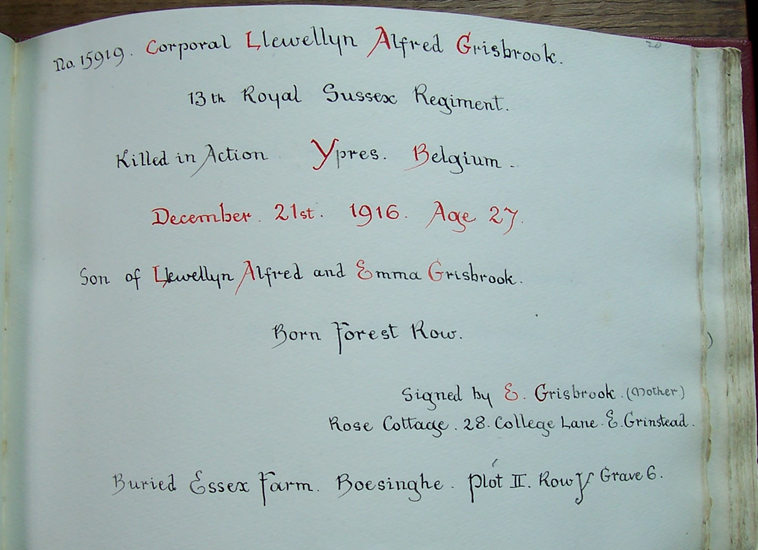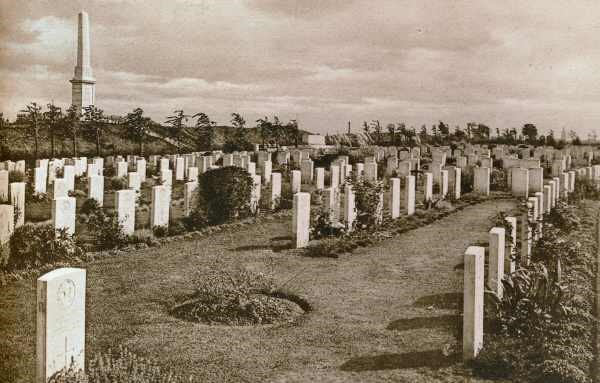LLEWELLYN ALFRED GRISBROOK
Corporal, G/15919, 13th Bn. Royal Sussex Regiment
Killed in Action, Ypres, Belgium, 21 December 1916, aged 27
Buried at Plot 2, Row Y, Grave 6, Essex Farm Cemetery, Boezinge
Corporal Llewellyn Alfred Grisbrook was born on 2 February 1890 in Forest Row, where he was also educated. His parents were Llewellyn Alfred Grisbrook and Emma Grisbrook (née Russell).
At the time of the 1891 census, Llewellyn, aged 1, was living in the High Street, Forest Row with his parents, both aged 23. His father, a railway porter, had been baptised in Hastings in 1867, and his mother in East Grinstead.
In 1901 Llewellyn, aged 11, was at the same address in Forest Row with his parents, and he now had a sister, Florence Emma Lily Grisbrook, born in Forest Row, who was aged 9. Llewellyn senior was now described as a coal carman.
In 1911, Llewellyn, now 21, was residing at Morris's Cottages, High Street, Forest Row. He was still single and recorded as a grocer's assistant. His father, now 43, was a bricklayer's labourer in the building trade, his mother was now 42, and they had a boarder, George Grantham, aged 18, a railway porter born in Crawley, living with them.
In another of the Morris's Cottages lived the family of John Jenner, also a bricklayer's labourer. Living nearby was Fanny Morris, a widow aged 47 described as of "private means" with a cook domestic aged 56. Close by was Morris's Stores where Mr. Ham and his family ran a grocer's and general stores.
On 28 April 1915, when he was 23, Llewellyn married Ethel Harris Garwood in East Grinstead. Ethel was born in Felbridge, Surrey, on 26 September 1892, the daughter of Daniel Garwood and Francis Elizabeth Godley.
Llewellyn enlisted on 8 April 1916, joining the 13th Service Battalion of the Royal Sussex Regiment, serving with the British Expeditionary Force in France and Flanders.
Llewellyn was killed in action on 21 December 1916. On 12 December the battalion had relieved the 17th Royal Welsh Fusiliers in the Turco Farm sector of the Western Front near Poperinge. On 21 December the battalion was stationed in the front line section of the Hill Top Farm sector of the Front. The battalion diary records:
"our artillery carried out a heavy bombardment of the enemy trenches on the right of the Divisional Front, which provoked a certain amount of retaliation. The Battalion regrets the loss of Corporal Grisbrook, killed, a very valuable NCO who had done good work."
The company chaplain later wrote to Ethel, saying:
"His Company Commander could speak in no higher terms of your husband than he did. He said he was one of the best men he had, and not only he, but we all deeply feel his loss."
On 17 May 1917 the sum of £1 19s. 6d. was credited to his widow Ethel, his sole legitimate heir. A War Gratuity of £4 0s. 0d. was approved for Ethel on 11 November 1919. At this time she was Ethel Rowcliffe of 19, Knox Road, Stamshaw, Portsmouth. According to an Ancestry tree, she had married Ernest Strong Rowcliffe (1891-1964), who had been born on Portsea Island, and she had three children. Ethel died in 1958.
Llewellyn Alfred Grisbrook was awarded the Victory Medal.
The Book of Remembrance in Holy Trinity Church, Forest Row, was signed by his mother, Emma, residing at Rose Cottage, 28 College Lane, East Grinstead. Llewellyn Alfred Grisbrook is commemorated on the Forest Row War Memorial.
Essex Farm Cemetery
Essex Farm Cemetery — photo and map
(Click to enlarge)
Essex Farm cemetery at Boezinge, West Vlaanderen (Boesinghe, West Flanders) in Belgium, lies just north of Ieper (Ypres) and holds 1,097 identified casualties with 103 unidentified graves. Land to the south of the cemetery was used as an Advanced Dressing Station from April 1915 to August 1917. The area was on the evacuation route for wounded soldiers from the nearby Ypres Salient. The cemetery was designed by Sir Reginald Blomfield but there was no definite plan for the burials.

Essex Farm Cemetery — Plan
(Click to enlarge)
It was here in May 1915 that Lieutenant Colonel John McCrae of the Canadian Army Medical Corps wrote the poem In Flanders Fields:
In Flanders fields the poppies blow
Between the crosses, row on row,
That mark our place; and in the sky
The larks, still bravely singing, fly
Scarce heard amid the guns below.
We are the Dead. Short days ago
We lived, felt dawn, saw sunset glow,
Loved and were loved, and now we lie
In Flanders fields.
Take up our quarrel with the foe:
To you from failing hands we throw
The torch; be yours to hold it high.
If ye break faith with us who die
We shall not sleep, though poppies grow
In Flanders fields.
McCrae died of pneumonia on 28 January 1918 and is buried in Wimereux Communal Cemetery.
Kevin Tillett
9 January 2017
Updated 28 October 2023




